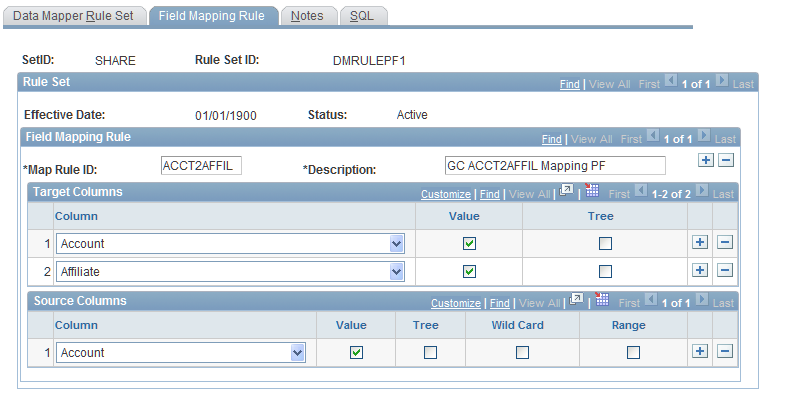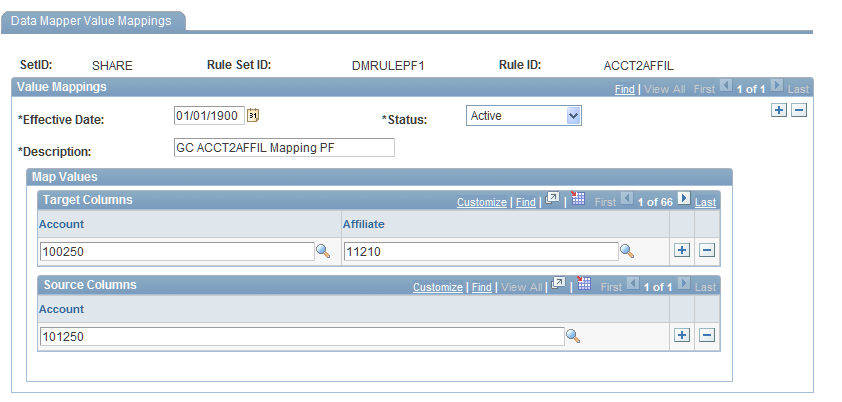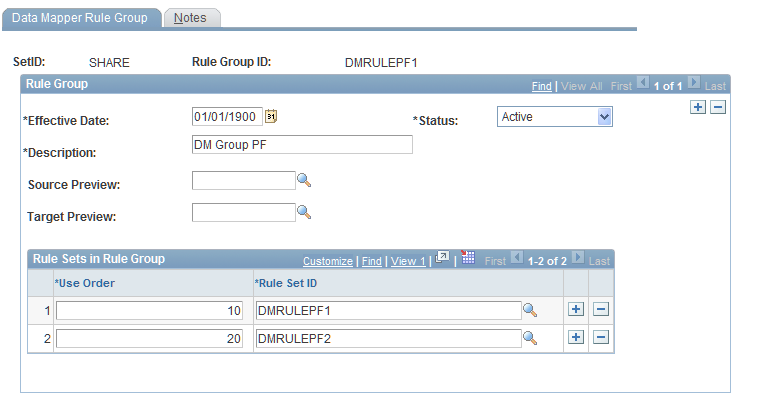Defining ChartField Mapping Rules
This section discusses how to:
Map to a common chart of accounts.
Establish data mapper rule sets.
Establish data mapper value mappings.
Establish data mapper rule groups.
Note: Data Mapper moves only data that falls within the intersection of all the map rules.
Pages Used to Define ChartField Mapping Rules
|
Page Name |
Definition Name |
Navigation |
Usage |
|---|---|---|---|
|
Data Mapper Rule Set |
PF_MAP_RULESET |
or
|
Define rules for mapping source staging ledger (SLED) ChartFields to the consolidation ledger. |
|
Data Mapper Rule Set- Field Mapping Rule |
PF_MAP_RULE |
or
|
Define the set of map rule IDs that are used on the Data Mapper Rule Set page when the mapping method is set to Map Rule. |
|
Data Mapper Rule Set - Notes |
PF_MAP_RULESET2 |
or
|
Enter notes about a data mapper rule. |
|
Data Mapper Rule Set - SQL (data mapper - Structured Query Language) |
PF_MAP_RULESET_SQL |
or
|
View the Structured Query Language (SQL) statements that result from the data mapper rule. |
|
Data Mapper Value Mappings |
PF_MAP_TBL |
or
|
Define how to map specific values within a ChartField from the source ledger to the consolidation ledger. This enables you to map one or more subsidiary accounts to a different account in your consolidation ledger. |
|
Data Mapper Rule Group |
PF_MAP_RULE_GRP |
or
|
Define the set of data mapper rules that comprise a rule group. |
|
Data Mapper Rule Group - Notes |
PF_MAP_RULEGRP2 |
or
|
Enter notes about the data mapper rule group. |
|
Data Mapper Preview |
PF_MAP_PRV_GEN |
or
|
Enables you to ensure that mapping has been setup correctly, depicting the results of a mapping. Use this process before the actual consolidation processes are run to populate the target tables. For a given combination of dimension values, you can preview the resultant target dimension values when applying the rulegroup. Data Mapper enables this preview by simulating a source that has a row for every combination of the various dimension elements, applying the rulegroup to that source and displaying the corresponding mapped target dimension elements. |
|
Data Map Preview Result |
PF_MAP_PRV_RES |
or
|
View the results of the Data Mapper Preview process. If there are errors, you can select a link from the Data Mapper Preview page that takes you directly to the page where the defined the map rules have errors. You can then correct the rules and continue to preview the results. |
Mapping to a Common Chart of Accounts (Data Mapper)
Before consolidation can take place, you must map all of the subsidiary ledgers requiring consolidation to a common chart of accounts. Potentially, each subsidiary ledger could have its own set of ChartFields and chart of accounts. To consolidate all these ledgers, you must map each of them to a common ChartField structure and common chart of accounts. The target consolidation structure can be completely different from one or all source structures.
Use the Data Mapper component to define how your subsidiary ledgers map to a common ChartField structure and common chart of accounts. You identify the datamaps that define the source data and the target table, and the method by which to map the data in a data mapping rule. When preparing data for Global Consolidations, the source data is a source staging ledger (SLED), and the target table is the corresponding mapping ledger (MLED).
Data mapping rules can be defined to:
Use any source staging ledger (SLED) as the source datamap.
Use any mapping ledger (MLED) as the target datamap.
Map to a target column by using the value from a source column, a fixed value, a range of values, wildcards, or a defined map.
Define maps with one or more source columns, mapped to one or more target columns.
Map source data with a value or a tree node.
Map to target columns with a value or a tree node.
Preview mapping results.
The mapping can include as many fields as exist in the source and target. If you add new ChartFields to either the source or target records, you can extend the mapping rule to include these new fields. Data Mapper rules are effective-dated, enabling you to control when to use new fields.
In addition, you can use Data Mapper rules to publish consolidation journals back to their source ledgers.
See Publishing Journals.
Steps to Map to a Common Chart of Accounts Using Data Mapper
Follow these steps:
Define the source datamap, the target datamap, filters, constraints, and any other metadata that will be used to map the data.
Define a Data Mapper Rule Set.
If the Data Mapper Rule Method is set to Map Rule:
On the Data Mapper Rule Set-Field Mapping Rule page, specify the source and target columns and how their values will be specified, and save the page.
Return to the Data Mapper Rule Set page, insert the field mapping rules that you defined, and then save the page again.
On the Data Mapper Value Mappings page, specify how to map the specific values within a ChartField from the source ledger to the target ChartField.
On the Data Mapper Rule Group page, combine the data mapper rule sets that you want to run together in the order in which they should be run.
On the Ledger Preparation Rule page, associate the data mapper rule group with the appropriate ledger business units.
Data Mapper Rule Set Page
Use the Data Mapper Rule Set page (PF_MAP_RULESET) to define rules for mapping source staging ledger (SLED) ChartFields to the consolidation ledger.
Image: Data Mapper Rule Set page
This example illustrates the fields and controls on the Data Mapper Rule Set page. You can find definitions for the fields and controls later on this page.

Define the Source, Target, and Mapping Method
Select the Source Datamap, Source Constraint, and Target Datamap, to define your source and target data. For Global Consolidations ledger preparation, the source datamap should be based on your source subsidiary staging ledger records (SLEDs), and the target datamap should be based on your mapping ledger record (MLED).
For ledger preparation, the source constraint must be defined on the source datamap, and limits which data is used from the source—for example, base currency amounts only. It must be based on a source staging ledger record (SLED).
In the Rule Set Columns grid, for each target column listed, specify the map method. The rule set columns are determined by the target datamap. These are the columns to which your source data will be mapped.
The Map Method column specifies how to map the data from source to target. Each map method requires an additional parameter, as described.
Define the Field Mapping Rules
Use the Data Mapper Rule Set- Field Mapping Rule page (PF_MAP_RULE) to define the set of map rule IDs that are used on the Data Mapper Rule Set page when the mapping method is set to Map Rule.
Image: Data Mapper Rule Set - Field Mapping Rule page
This example illustrates the fields and controls on the Data Mapper Rule Set - Field Mapping Rule page. You can find definitions for the fields and controls later on this page.

This page establishes the map rule IDs that are used on the Data Mapper Rule Set page when you select the Map Rule mapping method. Insert and define as many field mapping rules as needed to use with your data mapper rule set. For each map rule, complete the fields within the Target Columns and Source Columns grids to identify which columns you want to map and whether to use a value, tree, wild card, or range to specify which values to map. (You identify those values on the Data Mapper Value Mapping page.) Both source and target grids contains these fields:
These rules control which dimensions you can specify values for when mapping. If you select tree, then on the Data Mapper Value Mappings page, you can use tree nodes to specify the values. If you select value, then you select from a list of dimension or ChartField values. If you select range, then you select from a range of dimension or ChartField values. If you select wild card, then you select from a list of dimension or ChartField values based on your wild card designator. This is how the system determines which source values map to which target values.
Data Mapper Value Mappings Page (
Use the Data Mapper Value Mappings page (PF_MAP_TBL) to define how to map specific values within a ChartField from the source ledger to the consolidation ledger.
This enables you to map one or more subsidiary accounts to a different account in your consolidation ledger.
Image: Data Mapper Value Mappings page
This example illustrates the fields and controls on the Data Mapper Value Mappings page. You can find definitions for the fields and controls later on this page.

Within the Map Values group box, specify which source column values map to target column values. The above example maps source column 101250 to target account 100250 and affiliate 11210. By adding rows to the target columns, you can map source amounts to multiple affiliates.
Data Mapper Rule Group Page
Use the Data Mapper Rule Group page (PF_MAP_RULE_GRP) to define the set of data mapper rules that comprise a rule group.
Image: Data Mapper Rule Group page
This example illustrates the fields and controls on the Data Mapper Rule Group page. You can find definitions for the fields and controls later on this page.

In the Rule Sets in Rule Group group box, insert rows as needed to add all the data mapper rule sets that comprise this rule group. The rules that you include must define all the data in your subsidiary ledgers that need to be mapped to a consolidation ledger, because only one rule group is added to the consolidation model and processed during data preparation.
Enter the Use Order and specify the Rule Set ID for each inserted row. The rules are used in ascending order based on the value that appears in the Use Order field. If the same source data is mapped with more than one rule set, only the first one encountered is used. Each data row is processed only one time by the system. This means that if the first rule in a sequence handles a specific row, then the next rule excludes that row from its processing. The same rules, arranged in a different use order, may yield different results, so it is very important to set up the use order sequence exactly as you want the rules to be processed.